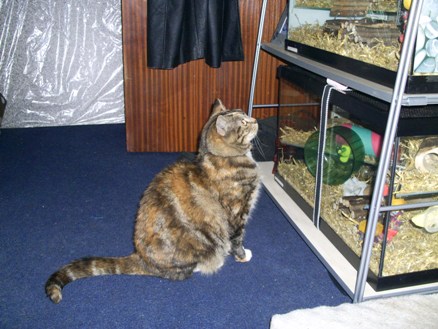Punishing cats for instinctual behaviour
A lot of the time online, I see posts about people unhappy with a cats behaviour who are seeking out ways to punish them or informing people how well something they’ve tried has worked.
While I understand cats in our home need to coexist peacefully with us, I’m troubled by behaviours cats are being punished for.
The main three “misdemeanours” seem to be scratching, hunting and toileting. (Either within the home, or in a neighbouring garden.)
When cats scratch items of furniture, it’s often due to three things; they have no actual scratch post available, the post provided is too small for the cat or the posts are in the wrong location. Scratching serves a couple of purposes to cats – it’s the way they naturally remove their claw sheaths and it’s also a way of marking their territory. The place a cat most often wants to mark is near entrances or exits in a home so that if there are any “feline intruders” it’s a clear signal they’ve stumbled into a space that’s already taken. A way to ensure your cat doesn’t scratch items of furniture you don’t want them to, is to send clear scent signals. Spraying catnip spray on the areas that it’s desirable they use, and a product called Pet Behave Spray (Citrus spray is known to be commonly effective as a deterrent too) on areas that aren’t means your cat can easily read the signs being given to them.
Hunting is something that horrifies many cat owners; but is ironically why cats became domesticated to the level they are today. Farmers realised they were a useful asset for vermin control and an alliance was formed. Nowadays, a lot of people have multi pet households which sometimes consist of both feline and rodent family members. There are ways to reduce the stress levels for rodents and make them safer, there are also ways to ensure a cat associates an unpleasant effect from being too interested in the household rodents. The training technique that’s most recommended is a water jet to the cats back end while they are actually “caught in the moment”; so if they’re actively tapping a cage. A cat will not recognise this behaviour as wrong; indeed, it isn’t. It’s an inherent instinct that has served them well and ensured they became integrated into human society. The purpose to the water jet is to ensure the cat feels less inclined to act on that instinct. However, if your cat has a strong prey drive most deterrents will prove pretty ineffective and you’ll have to resort to safety precautions for your rodent instead of trying to teach the cat to ignore their nature. Hunting outdoor rodents and birds is equally distressing to some cat owners, but it’s something that has to be faced; felines are predators, and will remain as such for some time. It’s not purely about sustenance to them and it’s something we should recognise and accept.
Toileting is the final issue that is commonly classed as a problem. As with scratching, toileting is another multi-purpose activity to a cat and again, its territory related. Urinating is common as a scent marker when cats are outdoors, especially with entire toms. Entire toms are also known to do something called maddening, which is leaving faeces uncovered as a clear signal to any cat wandering through their turf that the area is already occupied, so to speak. When cats are neutered they’re more likely to bury any ablutions outdoors. However, if cats use litter trays and suddenly stop there can be a few reasons. One is the location of the litter tray is in a place the cat feels uncomfortable toileting. Cats can also have a preference to litter type and a change in the litter that is used successfully has been known to cause inappropriate toileting. Another issue can be that cats don’t like doing their “ones and twos” in the same tray. A simple solution to that is to get two trays. Finally, and most importantly, inappropriate toileting can be a sign there is something wrong with your cats physical health. Cats with issues such as water infections have been known to start toileting elsewhere as they associate the pain of urinating with the place they usually toilet, so they try toileting elsewhere in an attempt to go to the toilet pain free. An old theory was that “rubbing an animal’s nose in their mess” would actually ensure that they never toileted inappropriately again. This is not a method that is advised. Cats are smart, but they don’t have the same thought process as humans. And when they toilet somewhere they shouldn’t, a lot of the time there IS a reason to it that we need to recognise, read and react to accordingly.
An interesting point; it’s believed that cats process emotion with the same parts of the brain as a human. While that’s true, it doesn’t mean they THINK the same way. Feline behaviour s and instincts are entirely different and we need to recognise that to ensure a happy coexistence can be reached.
Sage watching some of the rodent residents that shared our home

